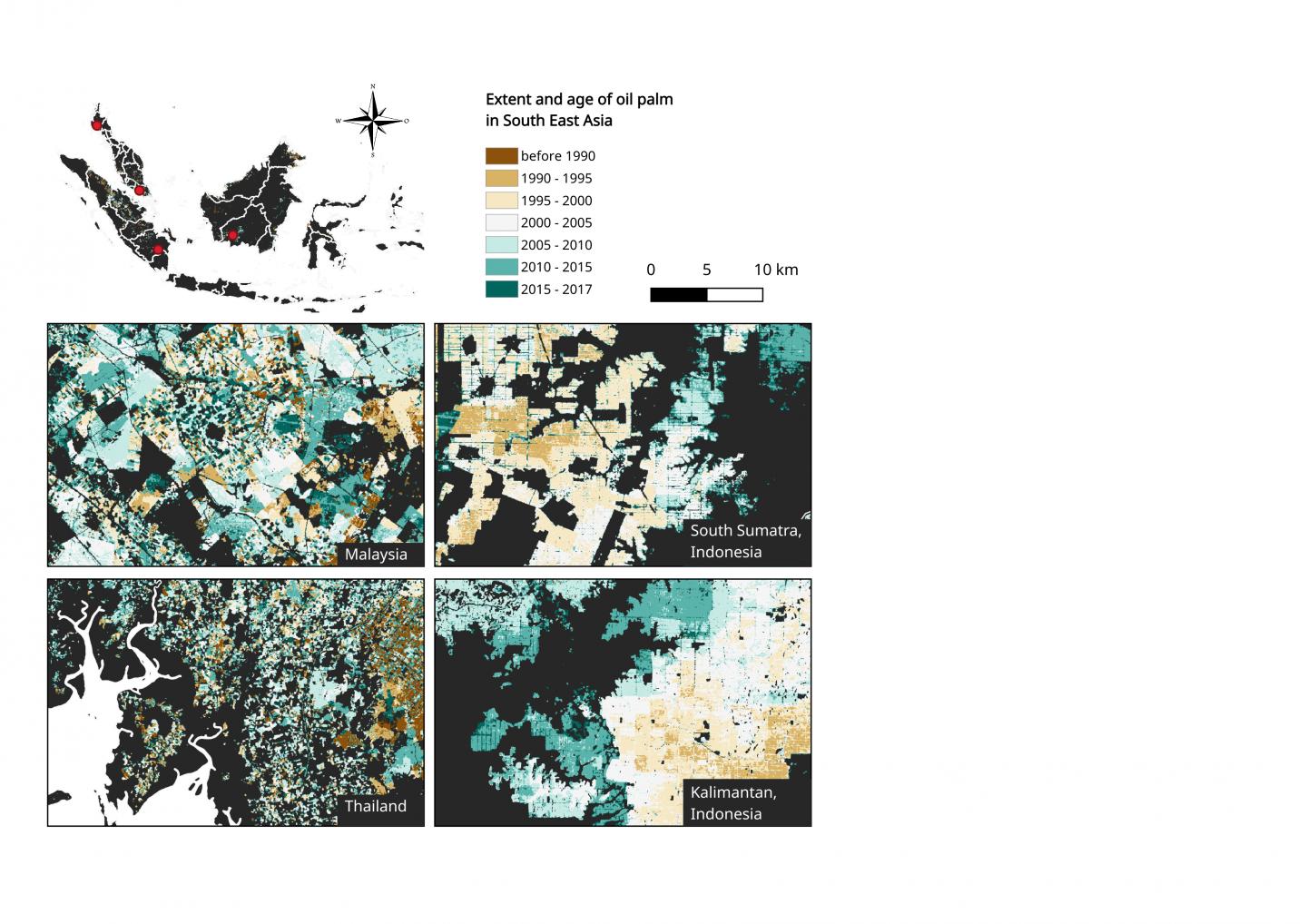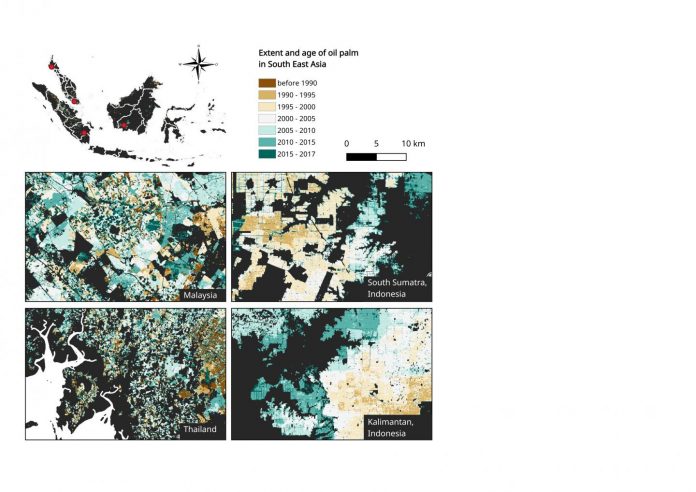
Photo: The extent and year of detection of oil palm plantations zoomed into four locations: Krabi, Thailand, Johor in Malaysia, Central Kalimantan and Riau in South Sumatra, Indonesia.
view more
Credit Image: Image produced using QGIS
IIASA researchers have used Sentinel 1 satellite imagery from the European Space Agency to produce a map of the extent and year of detection of oil palm plantations in Indonesia, Malaysia, and Thailand that will help policymakers and other stakeholders understand trends in oil palm expansion while also providing an accurate map for landscape-level planning.
The world’s appetite for palm oil seems to know no bounds. We use it in everything from beauty products and food, to industrial processes and biofuels to fulfill our energy needs. This ever growing demand has caused oil palm production to more than double in the last two decades, a development which has in turn deeply impacted natural forest ecosystems and biodiversity, while also significantly contributing to climate change by releasing carbon from converted forests and peatlands into the atmosphere. Today, almost 90% of the world’s oil palm production takes place in Southeast Asia. While oil palm is known to be the most efficient oil producing plant globally, yields vary dynamically with plantation stand age, management practices, and location. To understand trends in oil palm plantation expansion and for landscape-level planning, accurate maps are needed. To this end, IIASA researchers have provided a detailed map of oil palm extent in 2017 using *Sentinel 1 satellite imagery from the European Space Agency in a new paper published in Nature Scientific Data.
“We specifically wanted to determine the extent and age of oil palm plantations across Southeast Asia and see if we could use technologies such as Google Earth Engine and data mining algorithms to produce an accurate map of oil palm extent from Sentinel 1 radar data, which could potentially be operationalized into a near-real time oil palm detection system. In addition, we wanted to explore the possibility of using time series analysis to go backwards in time and determine the age at which the plantation can first be detected (i.e., when trees are around 2 to 3 years in age),” explains lead author Olga Danylo, a researcher with the IIASA Novel Data Ecosystems for Sustainability Research Group.
While oil palm extent has been mapped before, this paper uses Sentinel 1 satellite data in combination with other data sets to map extent, along with time series from the Landsat archive to derive the year of plantation detection (which is a proxy for productive age of the plantations). This additional information is valuable for examining questions related to oil palm expansion over the last two decades, as well as the ability to calculate yields from the age information. (Yields increase during the plant’s youth phase in the first seven years, reach a plateau during the prime age of 7-15 years, and then slowly start to decline before palms are replaced at the age of 25-30 years.) Therefore, knowing the exact extent and age of plantations across a landscape is crucial for landscape-level planning to allow for both sustainable oil palm production and forest conservation.
The paper’s key output is a 30 m resolution map of Southeast Asia that indicates if oil palm is present and the year of detection of the plantation – a brand new feature that allows for a better understanding of oil palm expansion in Southeast Asia. The oil palm extent map has an overall accuracy of 83%, which is comparable to other products. The largest area of oil palm can be found in Sumatra and Kalimantan, with expansions in all major regions since the year 2000. The maps shows that the largest relative expansions over the last decade have taken place in Kalimantan, insular Malaysia, and Thailand, but interestingly, the net oil palm plantation area, excluding milling facilities, roads, and other related infrastructure, might be significantly smaller than previously thought.
According to the researchers, the new map could furthermore support the calculation of estimates of greenhouse gas emissions and removals for specific regions, provide a means whereby official statistics can be independently verified, and could also be used in analyses related to determining the economic trade-offs in different types of land use. In addition, the oil palm map in combination with spatial information about estate boundaries could help to identify specific actors and their adherence to environmental legislation and compliance with sustainability standards.
“Buying certified palm oil (RSPO) is a means of avoiding tropical deforestation. Our map can inform which sites are eligible for RSPO certification and it can help policymakers such as the EU commission to make more accurate and directed policies in relation to palm oil by for instance excluding palm oil from certain (recently deforested) areas from biofuels in the EU,” concludes coauthor Johannes Pirker, a guest researcher with the Agriculture, Forestry, and Ecosystem Services Research Group at IIASA
The data set used in this paper is publicly accessible for download from the IIASA DARE repository.
* The Sentinel-1 mission comprises a constellation of two polar-orbiting satellites, operating day and night performing C-band synthetic aperture radar imaging, enabling them to acquire imagery regardless of the weather. Sentinel 1 satellite imagery is particularly valuable in tropical countries which are covered by clouds nearly all year.
###
Reference
Danylo, O., Pirker, J., Lemoine, G., Ceccherini, G., See, L., McCallum, I., Hadi, Kraxner, F., Achard, F., Fritz, S. (2021). A map of the extent and year of detection of oil palm plantations in Indonesia, Malaysia and Thailand. Nature Scientific Data DOI: 10.1038/s41597-021-00867-1
Contacts:
Researcher contact
Olga Danylo
Research Scholar
Novel Data Ecosystems for Sustainability Research Group
Advancing Systems Analysis Program
Tel: +43 2236 807 248
[email protected]
Johannes Pirker
Guest Research Scholar
Agriculture, Forestry, and Ecosystem Services Research Group
Biodiversity and Natural Resources Program
[email protected]
Press Officer
Ansa Heyl
IIASA Press Office
Tel: +43 2236 807 574
Mob: +43 676 83 807 574
[email protected]
About IIASA:
The International Institute for Applied Systems Analysis (IIASA) is an international scientific institute that conducts research into the critical issues of global environmental, economic, technological, and social change that we face in the twenty-first century. Our findings provide valuable options to policymakers to shape the future of our changing world. IIASA is independent and funded by prestigious research funding agencies in Africa, the Americas, Asia, and Europe. http://www.
TDnews (tunisiesoir.com)















